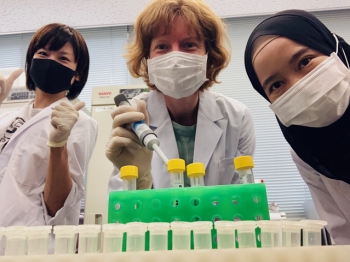
【2021.9.29】
Next-generation sequencing (NGS) is a cutting-edge technique for genetic analysis that can rapidly read genome sequences. At the Institute of Freshwater Biology, we have an Illumina NextSeq 550, and staff members Faulks, Fujimori, and Daryani are leading the analysis of a large number of Japanese eel samples.
As shown in the figure, the number of Japanese eel fry (glass eels) is greatly decreasing, and the IUCN has designated Japanese eel as an endangered species. Since eel farming relies on the harvest of these natural eels, which are then grown to adult size in aquaculture ponds, it is necessary to protect eel resources. In order to manage and conserve eel resources, it is necessary to understand the status of Japanese eel populations by using various methods. By analyzing the genome of Japanese eel using NGS, it is possible to estimate one indicator of population size, the effective population size.
This research is part of a research project led by the Institute of Freshwater Biology at Nagano University in collaboration with 35 universities, prefectural fisheries research institutes, and other experimental research institutes across Japan, as part of the Fisheries Agency's commissioned project to promote research and evaluation of fishery resources.
Next-generation sequencing (NGS) is a cutting-edge technique for genetic analysis that can rapidly read genome sequences. At the Institute of Freshwater Biology, we have an Illumina NextSeq 550, and staff members Faulks, Fujimori, and Daryani are leading the analysis of a large number of Japanese eel samples.
As shown in the figure, the number of Japanese eel fry (glass eels) is greatly decreasing, and the IUCN has designated Japanese eel as an endangered species. Since eel farming relies on the harvest of these natural eels, which are then grown to adult size in aquaculture ponds, it is necessary to protect eel resources. In order to manage and conserve eel resources, it is necessary to understand the status of Japanese eel populations by using various methods. By analyzing the genome of Japanese eel using NGS, it is possible to estimate one indicator of population size, the effective population size.
This research is part of a research project led by the Institute of Freshwater Biology at Nagano University in collaboration with 35 universities, prefectural fisheries research institutes, and other experimental research institutes across Japan, as part of the Fisheries Agency's commissioned project to promote research and evaluation of fishery resources.






